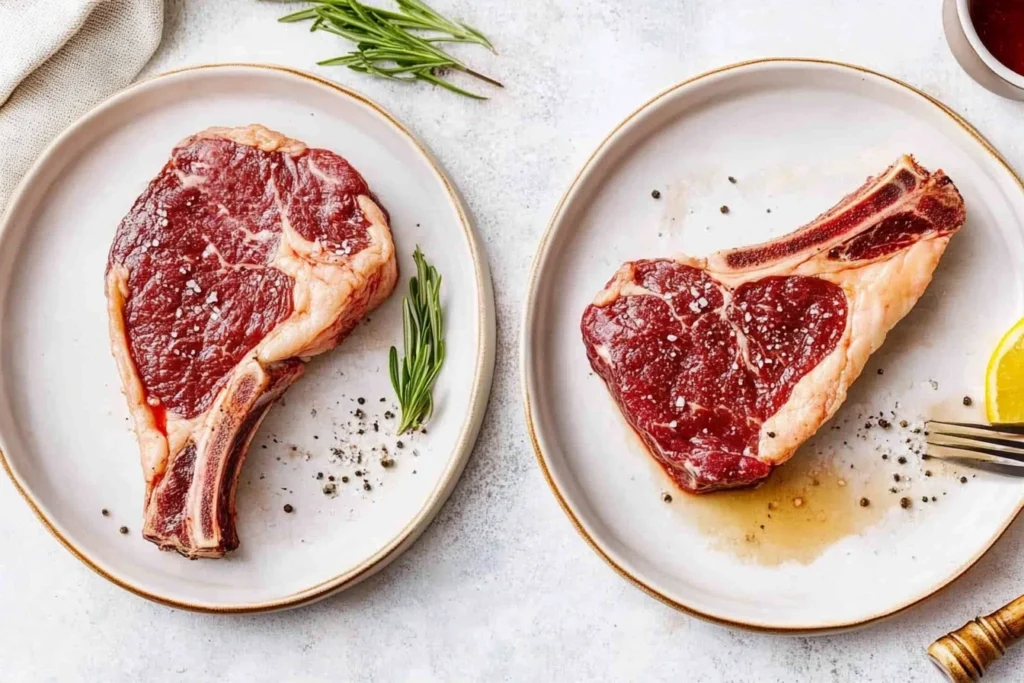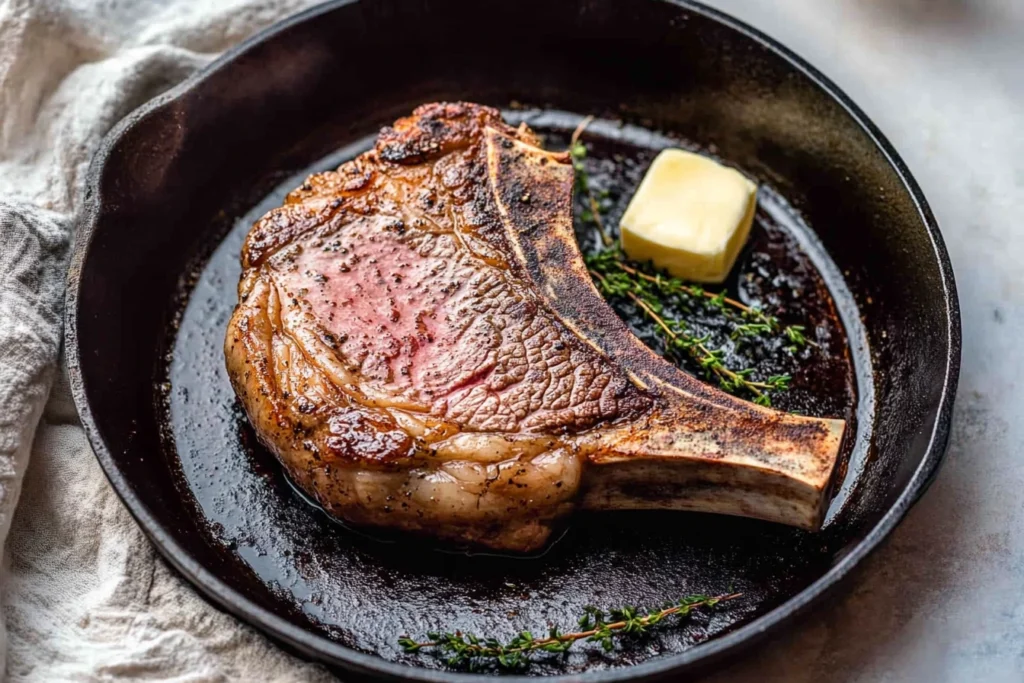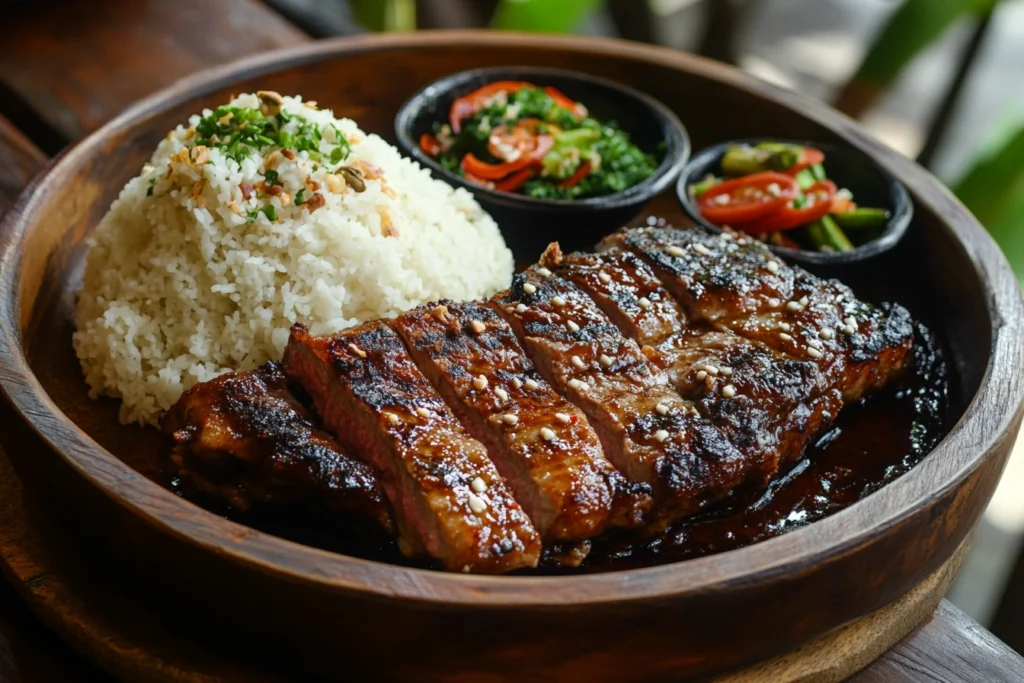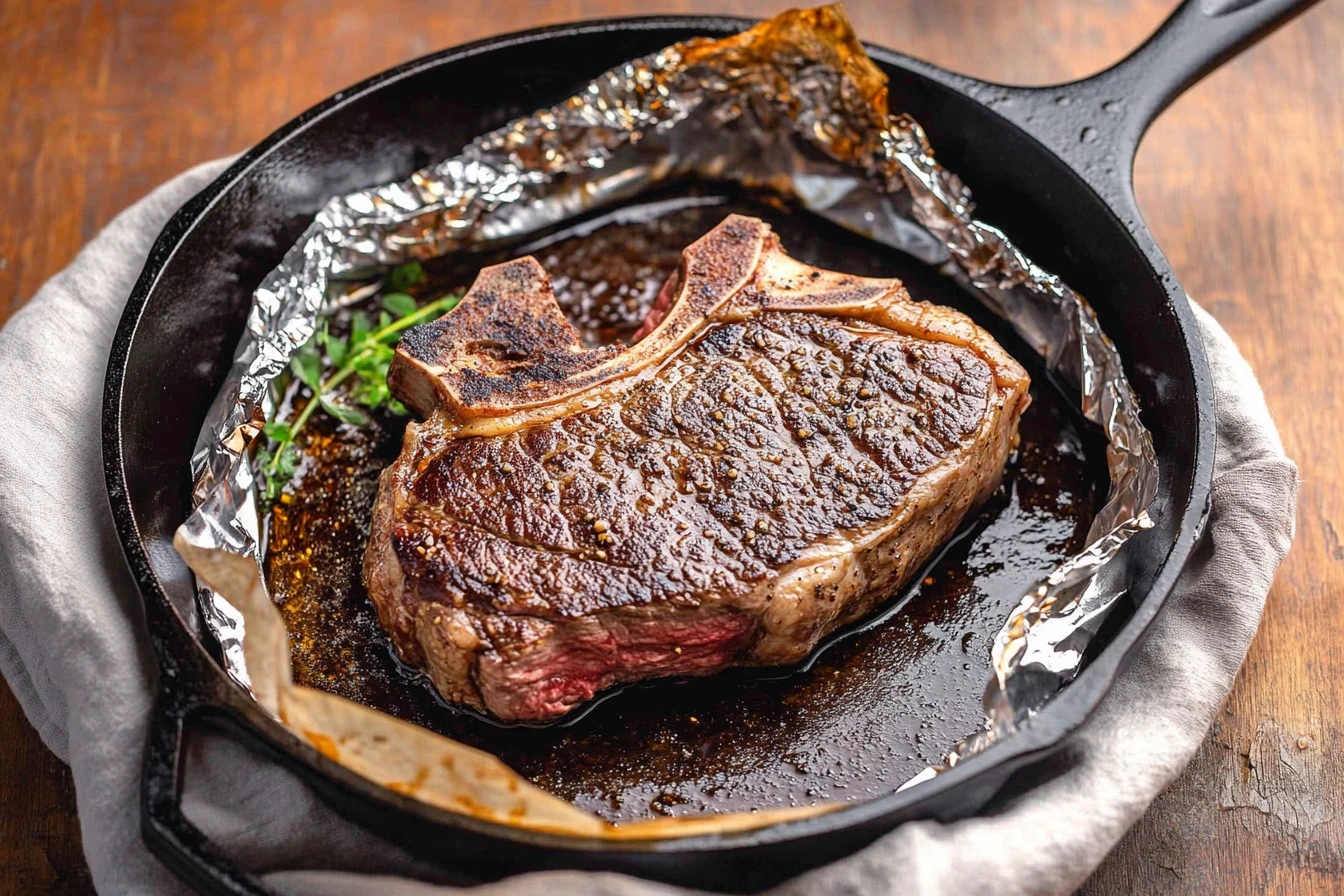Creating a restaurant-quality cowboy steak at home might seem daunting, but with the right techniques and understanding, you can master this impressive cut of beef. A properly cooked bone-in ribeye delivers an experience that combines bold flavors with stunning presentation, making it perfect for special occasions or when you simply want to elevate your dining experience.
Table of Contents
The Cowboy Steak
Before we dive into cooking methods, let’s understand what makes a cowboy cut steak special. This impressive cut is essentially a thick-cut bone-in ribeye, typically measuring 2-3 inches thick. The bone is French-trimmed, giving it that distinctive “handle” appearance that defines its rustic, cowboy-style presentation. The marbling throughout this prime cut promises exceptional flavor and juiciness when cooked properly.
Ingredients
For the Steak:
- 1 cowboy ribeye (2-3 inches thick, about 32-36 ounces)
- 2 tablespoons high-quality olive oil
- 2 tablespoons kosher salt
- 1 tablespoon freshly ground black pepper
- 4 cloves garlic, peeled and crushed
- 4 sprigs fresh thyme
- 2 sprigs fresh rosemary
- 3 tablespoons unsalted butter
Equipment Needed:
- Large cast-iron skillet or grill
- Instant-read meat thermometer
- Tongs
- Sharp knife
- Cutting board
- Timer
Step-by-Step Cooking Instructions
Preparing Your Cowboy Steak
The journey to a perfect cowboy ribeye begins well before it hits the heat. Remove your bone-in steak from the refrigerator 1-2 hours before cooking. This crucial step allows the meat to reach room temperature, ensuring even cooking throughout the thick cut. During this time, pat the steak dry with paper towels to remove any excess moisture – this helps achieve that coveted golden-brown crust.

Season your cowboy steak generously with kosher salt and freshly ground black pepper. The thickness of this cut demands more seasoning than you might expect. Consider this: a regular steak might need a teaspoon of salt, but your thick-cut bone-in ribeye needs roughly a tablespoon to properly season its substantial mass.
The Searing Process
Begin by heating your cast-iron skillet over medium-high heat until it’s smoking hot. Add olive oil and allow it to heat until shimmering. This high temperature is essential for developing a flavorful crust on your cowboy cut steak. Place your steak in the pan, allowing it to sear undisturbed for 5-7 minutes. You’ll notice a deep brown crust forming – this is the Maillard reaction creating complex flavors.

Adding Aromatics
Once you’ve flipped your steak, it’s time to enhance the flavors. Add butter, crushed garlic cloves, thyme, and rosemary to the pan. As the butter melts, it will combine with the meat’s juices to create a flavorful basting liquid. Tilt the pan slightly and use a spoon to continuously baste the cowboy steak with this aromatic butter mixture. This process adds layers of flavor while helping to cook the thick cut evenly.

Temperature Control
The thickness of a bone-in ribeye requires careful temperature monitoring. For medium-rare (recommended for this cut), you’re aiming for an internal temperature of 130-135°F (54-57°C). Insert your meat thermometer into the thickest part of the steak, avoiding the bone. Remember that the temperature will rise another 5-10 degrees during resting.
The Essential Rest
Perhaps the most crucial step in preparing a perfect cowboy steak is the rest period. Transfer your steak to a cutting board and let it rest for 10-15 minutes. During this time, the meat’s juices redistribute throughout the cut, ensuring each bite is succulent and flavorful. Tent loosely with foil to keep warm, but don’t wrap tightly as this can make the beautifully crusted exterior soggy.
Expert Tips for the Perfect Cowboy Steak
Understanding Heat Management
Mastering your cowboy ribeye requires understanding how heat interacts with this substantial cut. Think of cooking this thick bone-in steak like conducting an orchestra – you need to balance different elements perfectly. The initial high heat sear creates a flavorful crust, while moderate heat allows the center to cook evenly without burning the exterior. Consider using a dual-zone fire if grilling, or adjusting your stovetop heat strategically when pan-searing.
The Role of Marbling
Your cowboy steak contains beautiful marbling – thin streaks of fat distributed throughout the meat. As these fat deposits melt during cooking, they essentially baste the meat from within, creating pockets of flavor and maintaining juiciness. This is why allowing your steak to come to room temperature is crucial; cold fat doesn’t render as effectively as fat that’s closer to its melting point.
Seasoning Philosophy
When it comes to seasoning a cowboy cut steak, timing matters as much as quantity. Salt applied well before cooking (45 minutes or more) has time to penetrate the meat, enhancing flavor throughout. If you can’t season that far in advance, season right before cooking – anything in between can draw moisture to the surface, interfering with proper searing.
Serving Suggestions
A perfectly cooked bone-in ribeye deserves thoughtful accompaniments that complement without overwhelming. Consider serving with:

Robust red wine sauce infused with fresh herbs Roasted garlic butter melting over the hot steak Grilled seasonal vegetables that absorb the steak’s flavorful juices Twice-baked potatoes that match the steak’s impressive presentation
Temperature Guide
For optimal enjoyment of your cowboy steak, consider these temperature targets:
- Rare: 125°F (52°C) – A very red, cool center
- Medium-Rare: 135°F (57°C) – Warm red center, ideal for this cut
- Medium: 145°F (63°C) – Pink center, less juice retention
- Medium-Well: 150°F (66°C) – Slightly pink center
- Well-Done: 160°F (71°C) – Not recommended for this premium cut
Troubleshooting Your Cowboy Steak
When Your Steak Isn’t Developing a Proper Crust
Creating that perfect crust on your cowboy steak requires understanding a few key principles. If your steak isn’t developing that coveted brown exterior, the most common culprit is excess moisture. Think of it like trying to brown a wet sponge – it’s nearly impossible. Thoroughly pat your bone-in ribeye dry with paper towels before seasoning. Additionally, ensure your cooking surface is properly preheated. Just as you wouldn’t try to caramelize sugar on a lukewarm pan, your steak needs intense heat to develop its flavorful crust.
Dealing with Uneven Cooking
The substantial thickness of a cowboy cut steak can sometimes lead to uneven cooking, where the outside is perfect but the center remains too rare. Consider this challenge like warming up a cold house – you wouldn’t blast the heat at maximum and expect uniform warmth. Instead, use a two-stage cooking process: sear for the crust, then finish at a lower temperature. This method allows heat to penetrate gradually and evenly throughout the meat.
Frequently Asked Questions
Why is my cowboy steak tough?
Toughness often results from either overcooking or not allowing proper rest time. Think of your steak’s muscle fibers like a squeezed sponge – cutting too soon releases all the juices, leaving the meat dry and tough. Allow at least 10-15 minutes of rest time for the juices to redistribute throughout your bone-in ribeye.
Can I cook my cowboy steak from frozen?
While possible, cooking from frozen isn’t ideal for such a premium cut. The rapid temperature change can shock the meat, leading to uneven cooking. Instead, plan ahead and thaw your steak slowly in the refrigerator for 24-48 hours. This gentle thawing preserves the meat’s integrity and ensures even cooking.
How do I know when to flip my steak?
Rather than relying solely on time, learn to read your steak’s cooking signals. When the bottom edge of your cowboy ribeye starts showing a color change about 1/4 inch up the side, it’s typically ready to flip. This visual cue is more reliable than strict timing, as different pans and heat sources can affect cooking times.
What if my steak is too rare after cooking?
If your cowboy steak is underdone, resist the urge to return it to high heat. Instead, place it in a preheated 350°F oven until it reaches your desired temperature. This gentle heating method prevents the exterior from becoming overcooked while the center reaches perfection.
Bringing It All Together: Mastering the Art of Cowboy Steak
The Journey to Steak Mastery
Creating the perfect cowboy steak represents more than just cooking a piece of meat – it’s about understanding the intricate dance between heat, timing, and technique. Throughout this guide, we’ve explored how each element contributes to transforming a premium cut of beef into an extraordinary dining experience. Just as a sculptor reveals the beauty within marble, your careful attention to temperature, timing, and technique reveals the full potential of this magnificent bone-in ribeye.
If you enjoy experimenting with different steak techniques, you might want to try the Blue Steak Mastery guide, which offers expert tips on cooking steak to perfection.
Beyond the Basics
The true artistry in preparing a cowboy cut steak lies in the details that elevate it from good to exceptional. We’ve discovered how proper temperature management, from bringing the meat to room temperature to achieving the perfect internal heat, creates the foundation for success. The careful seasoning process, the importance of developing a proper crust, and the crucial resting period all work together in harmony to create something truly special.
For those who love bold and smoky flavors, The Ultimate Chipotle Steak Recipe is a fantastic way to explore spicier marinades and grilling techniques.
Understanding Your Growth
Like any culinary skill, mastering the cowboy steak takes practice and patience. Each time you prepare this impressive cut, you’ll develop a better understanding of how the meat responds to heat, how the marbling melts and enriches the flavor, and how small adjustments in your technique can lead to significant improvements in the final result. Think of each attempt as a step forward in your culinary journey.
If you want to experiment with another classic, Delmonico Steak is another rich, well-marbled cut that rewards careful cooking.
Looking Forward
As you continue to refine your technique with bone-in ribeye preparation, remember that perfection comes from understanding rather than just following steps. Pay attention to how the meat feels at different stages of cooking, how it responds to heat, and how the aromas develop. These sensory cues will become your guide, allowing you to cook with confidence and intuition.
If you’re looking for another beefy challenge, check out The Ultimate Guide to Perfectly Cooked Beef Ribs, which dives into slow-cooking methods to achieve fall-off-the-bone tenderness.
Final Thoughts
The satisfaction of serving a perfectly cooked cowboy steak extends beyond the dinner table. It represents a culmination of knowledge, technique, and patience – skills that will enhance all your culinary endeavors. Whether you’re preparing this cut for a special occasion or simply to enjoy its extraordinary flavor, remember that each step in the process contributes to creating a memorable dining experience.
If you ever find yourself with leftover steak, The Ultimate Steak Sandwich is an excellent way to enjoy it the next day.
Remember, cooking a cowboy ribeye is both a science and an art. While the science provides the foundation – the temperatures, times, and techniques – the art comes from your growing experience and understanding of this magnificent cut of beef. Continue to experiment, learn, and most importantly, enjoy the process of mastering this classic steakhouse favorite.
For more inspiration, consider trying The Ultimate Steak Pizzaiola, a saucy and savory take on a delicious steak dish.

